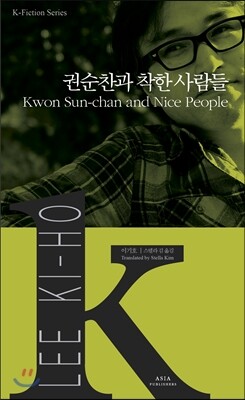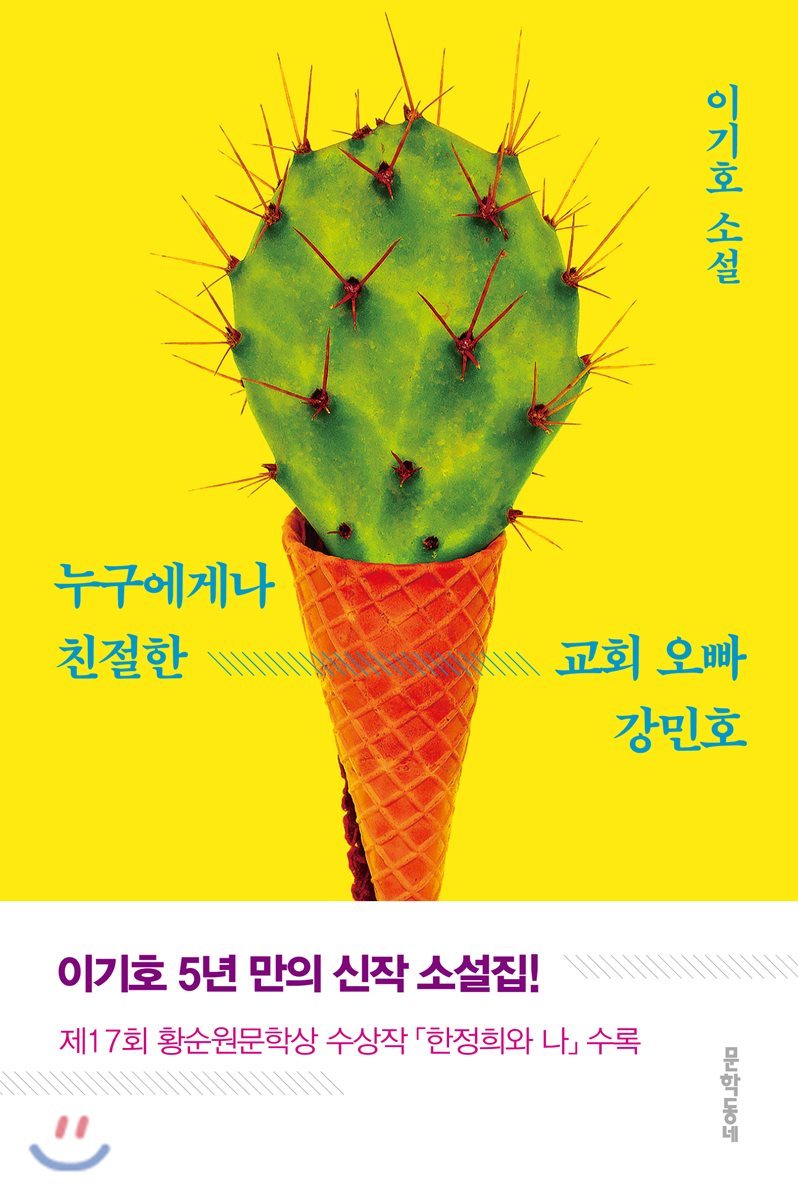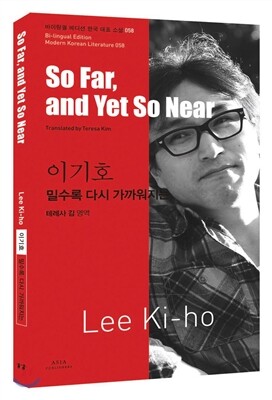Lee Kiho (born 1972) is a South Korean writer.
Life
Lee Kiho was born in Wonju, Gangwon Province. He studied creative writing at Chugye University For the Arts and earned his Ph.D. from Myongji University Graduate School's department of creative writing. Lee made his literary debut when his short story "Beoni" (버니 Birney) won the monthly Hyundae Munhak New Writer's Contest in 1999. He published his first collection of short stories, Choesundeok seongnyeongchungmangi (최순덕 성령충만기 Choi Sunduk: Filled with the Holy Spirit), in 2004.
Lee remembers listening to his grandmother's stories as a child and credits them as a formative influence on his writing: "[She] believed that the world wasn’t just made of the things we could see with our eyes—that, in fact, the world was made up of more things that were invisible to us. My grandmother told me stories about every elder in the village; stories about the lives they lived and the adventures they had. She also told me mysterious folktales about snakes turning into humans, or about the souls of the dead being absorbed into trees. It was much later that I realized that all my stories were rooted in her." [1]
Lee is the author of three novels and seven short story collections, including Sagwaneun Jalhaeyo (사과는 잘해요 At Least We Can Apologize), as well as a collection of essays. He is the recipient of the Lee Hyoseok Literary Award, the Kim Seungok Literary Award, and the Hwang Sun-won Literary Award. He is currently a professor of creative writing at Gwangju University.
Writing
Lee Kiho is considered to be one of South Korea's most unusual writers to the extent that one critic has declared that the conventions of a story cannot be applied to Lee's work. Lee debuted in 1999 with "Birney," a short story that reflects the rhythms of rap as well as pansori, a traditional Korean ballad. The stories following his debut are just as diversely experimental; one story borrows the question and answer method of an interrogation, while another adopts the writing style and typeset of the Bible, and still another uses language that is suggestive of the kind used on a TV cooking show.
Lee is inventive not only with form, but also with his characters, who are a humble and sordid lot: a small-time pimp who dropped out of high school after assaulting a teacher; a third-rate actor addicted to glue; a gang member who had grown up in an orphanage; and a character who ekes out a living by working at a local convenience store. Lee's stories not only feature these back alley types, but also those with abnormal traits, such as a youth who has eyes in the back of his head and a man who falls in love with a flagstaff from where the national flag hangs.
These misfits, who seem to have jumped straight out of tabloids or entertainment programs, are distinctive and, at the same time, very real individuals who can be easily found on the fringes of society. A character named Lee Sibong, who appears regularly in Lee's work, is portrayed a little differently in each story but is, for the most part, a pathetic and naïve flunky with no luck whatsoever, someone who seems to be the epitome of human failure. By ridiculing the lives of these vulgar yet common characters, Lee makes his readers laugh. However, the target of our laughter quickly becomes our own society that is steeped in arrogance and artifice, for the characters’ vulgarity, naiveté, and tragic failures symbolize the failings of our society.
Lee's latest novel, Mogyangmyeon banghwa sageon jeonmalgi: yopgi 43jang (목양면 방화 사건 전말기 - 욥기 43장 Circumstances of the Fire at Mogyang: Job: 43), is the author's answer to the Book of Job: "It takes place after the Bible story; he has a bad relationship with the children born to him after his ordeals and is hurt because of the friction between them. I’m calling it The Book of Job, Chapter 43." [1]
References
[1] Korea Literature Now. Vol.40, Summer 2018. https://www.kln.or.kr/frames/interviewsView.do?bbsIdx=395
Lee Kiho está considerado uno de los escritores más singulares de Corea del Sur, hasta el punto que un crítico ha declarado que las convenciones del relato no pueden aplicarse a su obra. Debutó en 1999 con "El conejo", un relato que parece reflejar los ritmos del rap, además del pansori, un tipo de canción tradicional coreana. Los relatos que siguieron al de su debut son variados y experimentales: para una historia toma el método de las preguntas y las respuestas propio de un interrogatorio, mientras que en otra adopta un estilo de escritura formulaico como el de la Biblia, y en otra usa un lenguaje sugerente del tipo de los que se usan en programas de cocina de la televisión.5Su inventiva no solo está en la forma sino también en los personajes, que son sórdidos y humildes a la vez: un chulo de pacotilla que deja la escuela después de pegar a un profesor; un actor de tercera adicto al pegamento; un miembro de una banda que creció en un orfanato; y un personaje que vive a duras penas trabajando en una tienda de 24 horas. En sus historias no solo aparecen los típicos personajes de los callejones, sino también los que tienen rasgos subnormales, como el joven que tiene ojos en la nuca y el hombre que se enamora del mástil en el que flamea la bandera nacional.
Estos inadaptados sociales, que parecen haber salido de la página de policiales o de programas de entretenimiento, son peculiares, pero al mismo tiempo personas muy reales que se pueden encontrar en los límites de cualquier sociedad. Un personaje llamado Lee Sibong, que aparece de forma regular en sus obras, está descrito de forma un poco diferente en cada historia, pero la mayoría de las veces es un lacayo sin ninguna suerte, alguien que parece ser el epítome del fracaso humano. Al ridiculizar las vidas de los personajes vulgares pero comunes, Lee Kiho hace reír a los lectores. Sin embargo, el objetivo de nuestra risa pronto es la propia sociedad embebida de arrogancia y artificialidad, puesto que la vulgaridad, la ingenuidad y los fracasos de los personajes simbolizan los fracasos y las fallas de nuestra sociedad.7Se ha traducido una de sus novelas al inglés Al menos sabemos disculparnos en 2003. Se ha descrito como una novela posmodernista y algo absurda, pero divertida de leer en al menos dos niveles. Primero en el nivel superficial, por el ridículo rumbo de los sucesos. En segundo lugar, como metáfora de la habilidad del poder de infundir culpa en la gente que no tiene poder alguno con el fin de poder tener el control de la situación y el modo en que eso se puede descontrolar del todo cuando la relación se desequilibra.8En 2012 ganó el Premio Literario Lee Hyo-seok.
Il est considéré comme l'un des écrivains les plus singuliers de Corée du Sud dans la mesure où un critique a déclaré qu'aucune convention narrative ne peut être appliquée à son œuvre. Il a fait ses débuts en 1999 avec Lapin (Tokki), une nouvelle qui semble adopter le rythme du rap en même temps que celui du pansori, une façon traditionnelle de chanter en Corée. Les histoires qui suivent ces débuts sont également expérimentales. Ainsi, l'une d'entre elles emprunte la méthode des questions-réponses d'un interrogatoire, tandis qu'une autre adopte le style d'écriture que l'on retrouve dans la Bible; enfin un autre de ces récits utilise une manière de parler propre aux émissions de cuisine à la télévision4.Lee Kiho est un auteur inventif, non seulement avec la forme, mais aussi avec ses personnages, qui sont souvent des personnages sordides. On retrouve ainsi dans ses récits un proxénète vivant à la petite semaine qui a abandonné l'école après avoir agressé un professeur; un acteur de troisième ordre accro à la colle; un membre d'un gang qui a grandi dans un orphelinat; ou encore un personnage qui gagne péniblement sa vie en travaillant comme dépanneur à domicile. Ses histoires mettent en scène des marginaux mais aussi des personnages avec des traits anormaux, comme un jeune qui a des yeux derrière la tête ou un homme qui tombe amoureux d'un mât où un drapeau flotte au vent.
Ces marginaux, qui semblent tout droit sorti des tabloïds ou des programmes de divertissement, se distinguent de la masse et sont en même temps, pour la plupart, crédibles dans la mesure où ils correspondent aux personnes vivant à la frange de la société. L'auteur fait souvent intervenir un personnage nommé Lee Sib-ong, qui est représenté un peu différemment dans chaque histoire. Il est décrit la plupart du temps comme un larbin pathétique et naïf, qui semble être la quintessence des faiblesses humaines. En ridiculisant la vie de ces personnages, Lee veut avant tout faire rire ses lecteurs. Cependant, la cible de ce rire devient rapidement notre propre société ancrée dans l'arrogance et l'artifice. La vulgarité des personnages, leur naïveté, et leurs échecs tragiques symbolisent les lacunes de notre société4.En 2010, Lee a remporté le prix littéraire Yi Hyo-seok5.Un de ses romans a été traduit en anglais, Au moins on sait bien s'excuser (Sagwaneun jalhaeyo) paru en 20136. Ce roman est dit « post-moderne » : il est écrit sur un ton légèrement absurde, offrant un plaisir de lire à deux niveaux. Il offre d'abord un plaisir de lire concernant sa structure, le roman étant constitué d'événements plus grotesques les uns que les autres. La deuxième qualité réside dans sa capacité à délivrer une métaphore des horreurs du pouvoir, notamment par la faculté des personnages de réussir à culpabiliser les marginaux parce qu'ils ne sont pas dans le système6.
1972年、江原道原州市に生まれる。1999年『現代文学』に短編小説『버니(バニー)』を発表し作品活動をスタートした。この作品はラップ音楽から生まれたようでもあり、韓国伝統民族芸術の一つであるパンソリのリズムも感じられる作品である。その後発表した作品も被疑者調書の問答形式を借用したり、聖書の文体と組版形式を借りるなど、様々な形式的実験を繰り返している。また、小説の中の登場人物も独特かつ異常な人々が多いが、私たちの周りに一人はいそうな現実的なところも持っている。李の小説は非常に愉快で生き生きしているが、社会に対する深い省察とパトスを感じることができるのが大きな魅力だと言える。
Ли Гихо родился в 1972 г., дебютировал в 1999 г., опубликовав рассказ «Bunny» в журнале «Современная литература (Хёндэ Мунхак)». В 2010 г. получил литературную премию имени Ли Хёсока, в 2013 г. – литературную премию имени Ким Сынука и в 2014 г. – литературную премию газеты «Хангук Ильбо». В настоящее время является профессором литературного творчества в университете «Кванджу». Среди его произведений сборник повестей «Как Чхве Сондок исполнился Святым Духом», «Я так и знал, что так и будет из-за моей нерешительности», «Кто такой доктор Ким?» Среди романов Ли Гихо следует назвать «Я умею хорошо извиняться» и «Мировая история вторых сыновей». Роман «Мировая история вторых сыновей» является продолжением романа «Я умею хорошо извиняться» и второй частью «Трилогии греха». В романе «Я умею хорошо извиняться» затрагиваются вопросы отношения к греху и проблема непрощения, а в романе «Мировая история вторых сыновей» описывается история человека, который в начале 1980-х гг. по воле судьбы оказался беспричинно обвинен военным режимом и пытается всеми силами доказать свою невиновность. Автор, описывая эту ожесточенную борьбу несломленного героя против бесчеловечного режима, представляет на читательский суд вопрос преступления и наказания, возникающий в отношениях отдельной личности и государства.
小说家李起浩生于1972年。1999年在《现代文学》发表了短篇小说《bunny》,从此登上文坛。2010年获得李孝石文学奖,2013年获得金承钰文学奖,2014年获得《韩国日报》文学奖。作者现为光州大学文艺创作专业专职教授。作品有小说集《崔顺德圣灵充满记》、《茫然不知所措之后我知道会这样》、《金博士是谁?》和长篇小说《擅长道歉》、《次子们的世界史》等。<次子们的世界史》是继《擅长道歉》之后, 作家策划的“罪恶三部曲” 中的第二部作品。《擅长道歉》探讨了人和人之间的负罪感;《次子们的世界史》则以20世纪80年代初为背景,讲述了军事政权下,意外受到通缉的主人公为证明自己的清白而苦战的故事,探讨了个人和国家之间罪与罚的问题。
이기호(1972~)는 대한민국의 소설가다.
생애
이기호는 1972년 강원도 원주에서 태어났다. 추계예술대학교 문예창작학과를 졸업하고 명지대학교대학원 문예창작학과에서 박사과정을 수료했다. 1999년 《현대문학》에 단편소설 〈버니〉가 당선되며 작품 활동을 시작했다. 작가는 이효석문학상(2010)을, 황순원문학상(2017), 동인문학상(2018) 등을 수상하며 활발한 작품 활동을 하고 있다. 광주대학교 문예창작학과 교수로 일하고 있다.
작품 세계
이기호는 현실에 대한 비판적인 시선을 바탕으로 인간의 죄와 죄의식, 욕망 등을 유쾌하고 유머러스한 문장으로 소설에 담아내고 있다. 특히 개인과 개인 사이의 죄의식 그리고 국가권력이 개인에게 행사하는 폭력에 대한 고발, 삶의 슬픔과 환멸 등을 유쾌한 화법으로 담아내어 작가만의 스타일을 구축하고 있다.
첫 소설집 《최순덕 성령충만기》(2004)는 여러 잡지에 발표해온 여덟 편의 작품을 모아 묶었다. 작가는 절에서 길러진 고아, 지하철 앵벌이, 생활에 찌든 무능한 가장, 자기 이름 밖에 쓸 줄 모르는 청년, 민통선 근처에서 감자 농사를 짓는 여성 등 사회 주변부로 밀려난 사람들을 작품집의 주제로 삼았다.
첫 장편소설 《사과는 잘해요》(2009)에서 작가는 사과를 대신 해주는 사람들 속에 숨어 있는 죄와 죄의식에 대해 이야기한다. 일자리를 구하지 못한 주인공인 두 청년은 자신들이 가장 잘하는 일인 '사과하기'로 돈을 벌기로 마음먹는다. 두 청년은 사과 대행 업무를 할수록 사람들이 감추고 있는 은밀한 죄와 죄의식을 마주하게 되고 이를 통해 자신들의 욕망에 다다르게 된다.
장편소설 《차남들의 세계사》(2014)는 2009년 가을부터 2010년 겨울까지 계간 《세계의 문학》에 연재했던 <수배의 힘>이 제목을 바꿔서 출간된 작품이다. 소설은 우연히 1982년 3월의 '부산 미문화원 방화사건'에 연루되어 수배자 신세가 된 주인공의 삶을 통해 1980년대 광기의 역사 속에서 한 개인의 삶과 꿈이 어떤 식으로 파괴될 수 있는지를 보여 준다. 작가는 1980년대 초반을 배경으로 군사정권 아래 뜻하지 않게 수배당한 인물이 자신의 무죄를 증명하기 위하여 악전고투하는 이야기를 통해 개인과 국가 사이의 죄와 폭력에 대해서 문제를 제기한다. 작가는 부조리한 삶과 인생의 아이러니를 매력적인 캐릭터, 유머와 익살을 통해 공감을 이끌어 낸다.
소설집 《웬만해선 아무렇지 않다》(2016)는 아무리 노력해도 삶이 나아지지 않는 불안한 현실 속에서 어떻게 살아야 하는가의 문제를 주제로 삼은 이야기들이 수록된 작품집이다. 작가는 폼 나는 사람들, 세련된 사람들이 아닌 전전긍긍하고 갈팡질팡 하는 우여곡절 많은 사람들, 최선을 다한 사람들이 맞닥뜨린 삶의 어떤 순간을 포착하고 있다. 가난하지만 정직한 사람들의 삶의 비애를 작가 특유의 익살로 되살려내었다.
주요 작품
1) 소설집
《최순덕 성령충만기》, 문학과지성사, 2004.
《갈팡질팡 하다가 내 이럴 줄 알았지》, 문학동네, 2006.
《김 박사는 누구인가》, 문학과지성사, 2013.
《웬만해선 아무렇지 않다》, 마음산책, 2016.
《세 살 버릇 여름까지 간다》, 마음산책, 2017.
《누구에게나 친절한 교회오빠 강민호》, 문학동네, 2018.
《누가 봐도 연애소설》, 위즈덤하우스, 2020.
2) 장편소설
《사과는 잘해요》, 현대문학, 2009.
《차남들의 세계사》, 민음사, 2014.
《세 살 버릇 여름까지 간다》, 마음산책, 2017.
《목양면 방화 사건 전말기》, 현대문학, 2018.
3) 수필집
《독고다이 獨 GO DIE》, 랜덤하우스코리아, 2008.
수상 내역
2010년 제11회 이효석문학상
2013년 제1회 김승옥문학상
2014년 제47회 한국일보문학상
2017년 제17회 황순원문학상
2018년 제49회 동인문학상





